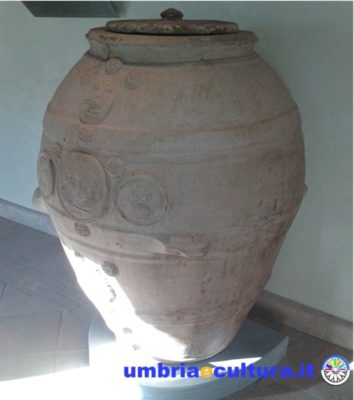Why should we visit a Museum of Bricks? Bricks are used to realize buildings and have nothing to do with culture, art, beauty. Nothing could be further from the truth. I realize it as soon as I enter the first rooms of the Museum.
The brick is a fundamental component of human life, from when man started to build dwellings that could be considered so. Such objects seem not to be interesting at all, but for those who have the sensitivity to see and hear, they are able to tell us our history, the daily one, perhaps less important, but more intimate and closer to each of us.
Let’s start the visit in the museum: the first rooms examples of Roman bricks found in theMarsciano area are on display. A clear sign that the area has always been devoted to the activity of working with clay, from ancient times to the present days. Then we move on to the rooms where craftsmanships of pre- industrial era are shown, full of poetry, in my opinion… The poetry of a hard job that required the complete symbiosis of man’s work with the rhythms of nature and seasons. A year was the time necessary to achieve a firing in the kiln: between October and December the firewood needed to cook the pieces was cut and the clay was quarried. The wood dried and the clay became more resistant because of the chemical binders; the months of January and February no activities took place because of the bad weather and low temperatures. From March onwards process itself took place: the clay was kneaded with water, placed in molds to realize the objects needed, and then left to dry naturally until the arrival of summer, the time in which the pieces were cooked in the furnace, all together, according to a particular a technique suitable, to avoid as much as possible, breakage and waste. The firing lasted 15 days, during this time the workers involved, without stopping, worked to keep the furnace at a stable temperature. Simple thing to say, but a deep knowledge of the work and huge technical expertise was needed, because there were no thermostats or thermometers for measuring. Examples of artifacts are shown to illustrate the production.
With the arrival of the industrial Hoffman furnace, all these steps were “forced” and the production became intensive and, for the first time, it was possible to produce the perforated brick. The reconstruction of an Etruscan tomb of the fourth century BC, found in the territory of Marsciano, with its accompanying terracotta ornaments is on display. Given the large number of bowls and various containers it should be the tomb of a woman who used these objects to contain perfumes, cosmetics and for kitchen use.
The highlight of the production and use of terracotta objects for daily house use took place in 1800, we can see (or see again, for those who still have the memory of a simple peasant life, far from being tied to consumerism) the objects in all the farmhouses in Umbria and beyond : pans, “stufarole” of various shapes, the “pretine” (like hot water bottles), warmers that were filled with ash, kettles that were used on the barrels to raise the boiling wine, soup bowls, dripping pans. The pitchers, the “colaerba” to dry boiled vegetables. A large container for washing clothes, with a hole at the bottom, to let the clothes soak with ash or lard, before being washed and rinsed.
Once damaged, the pieces, so precious, could not be thrown away. Here then the mastery of “Ferrapignatte” the man who gave a second life to objects blocking them in a network of iron wire or expertly sewing the pieces of the borken object together to allow further use… how far is all this from our reality…
The gallery of the jars is breathtaking: a theory of large jars, decorated, perfectly preserved and very ancient and rare, lead us to the other rooms of the Museum. The jars may be for olive oil (potbellied and with the only opening in the upper part) and for vinsanto (with holes for the insertion of taps that allowed to draw the contents).
Finally we can enjoy a collection of whistles. The most varied forms and styles have inspired the creation of these pieces from all over Italy and the world. Whistles were and are used for fun but they are used, in some populations, to ward off evil and attract the forces of good. There are whistles in the shape of Saints (there is also the religious meaning).
At the end of this journey the concept of “Brick” is quite different… it’s our little daily history, rooted in each of us, is the simplicity of everyday use objects, that talk about of our lives.
by Benedetta Tintillini



